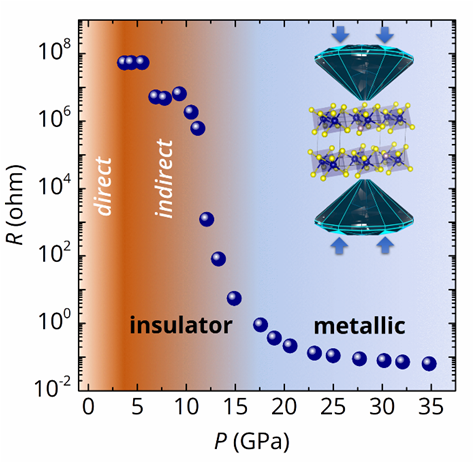Band gap crossover and metallization in the compressed CrPS4 - Drs. Resta Susilo and Bin Chen
AUGUST 20, 2020
In a new work, an international team led by Drs. Resta Susilo, Bo Gyu Jang, DuckYoung Kim and Bin Chen from HPSTAR reported a band gap crossover which is successively followed by an insulator-metal transition in the vdW antiferromagnetic insulator CrPS4 under pressure. The result is published recently in npj Quantum Materials.
Two-dimensional van der Waals (vdW) magnetic materials serve as possible candidates for future ultrathin spintronic devices, and finding a way to tune their physical properties is desirable for wider applications. CrPS4 is among vdW magnets that currently receives significant interests due to its unique properties. Unlike other vdW magnets in which the properties depend on the interlayer interactions, the optical, electronic and magnetic properties of CrPS4 are strongly related to the Cr3+ ions. This suggests that altering the environment of the Cr3+ ions would effectively tune the physical properties of CrPS4. In this work, by using in-situ photoluminescence (PL) and optical absorption in diamond anvil cell, anomalous behaviour was observed in the PL and absorption spectra of CrPS4 at around 3 GPa. Further compression led to the gap closure, i.e. metallization, which is confirmed by electronic transport measurements. While Raman spectra revealed no change at around 3 GPa, a clear Raman change was observed across the metallization transition above ~15 GPa.

Caption: Phase diagram of the electronic and optical properties of CrPS4 at high pressure.
In order to provide insights for the observed behaviour, state-of-the-art Dynamical Mean Field Theory (DMFT) calculations were employed to calculate the electronic structures of CrPS4 at room temperature. It is revealed that the anomalies in the PL and absorption spectra at ~3 GPa is related to the band gap crossover (direct-indirect) in the paramagnetic state. Calculations show that the band gap crossover is driven by the shrinkage and rearrangement of the surrounding environment of the Cr3+ ions, in this case the CrS6 octahedra, instead of the modification of the interlayer interactions. This is further confirmed from the calculated Raman spectra that reproduced the Bg3 and Ag2 modes crossover seen in the experimental Raman data. Raman spectra and calculations also revealed that the insulator-metal transition in CrPS4 at around 15 GPa is accompanied by the formation of the high-pressure phase, which suggests that it is not a bandwidth-controlled Mott transition. This finding demonstrates an interesting interplay between structural, optical, and magnetic degrees of freedom in CrPS4, and provides further opportunity for the development of devices based on tunable properties of 2D vdW magnetic materials.
二维范德瓦尔斯磁性材料由于其在自旋器件方面的潜在应用前景而受到人们的广泛关注。CrPS4是有着丰富变磁行为的范德瓦尔斯反铁磁材料,其独特的物理性能主要是由CrPS4结构中的三价铬离子决定的,因此改变三价铬离子周围的局域结构很有可能对二维范德瓦尔斯材料CrPS4的物理性能起到很大的改变,将有助于使其更好的实现应用。北京高压科学研究中心的 Resta Susilo博士带领的最新研究报道了压力对范德瓦尔斯反铁磁材料CrPS4物理性能的调控。他们CrPS4材料的能带结构在大约3 GPa下会由直接带隙转变为间接带隙,随着压力的进一步增加到大约15 GPa时,带隙闭合,CrPS4由绝缘体转变为金属。他们进一步的计算表明CrPS4能带的转变是由于三价铬离子周围原子的收缩以及重组导致的,压力引起的CrPS4晶体结构的最终变化导致了CrPS4由绝缘体转变为金属。他们的研究表明压力可以有效调节二维范德瓦尔斯磁性材料的物理性能,有助于帮助我们获得性能优越的自旋器件。
